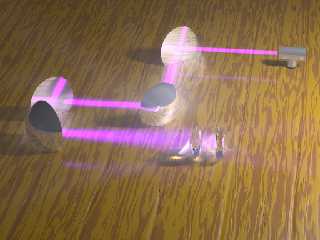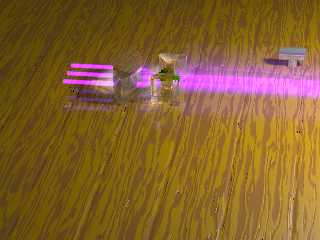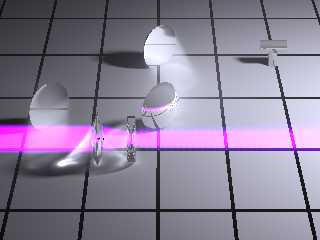 |
 |
|
 |
|
 |
|  |
|  |
|
 |
|
 |
|  |
|  |
|
 |
"Jim Holsenback" <jho### [at] hotmail com> wrote:
> what about thickness of the lens? that was to be my next test until i got
> side tracked
Doh!
also , area_light is missing at least 2 important items:
fade_distance
fade_power
3 media levels exist around:
spacing 0.05
media 200
max_trace_level 10
spacing 0.075
media 150
max_trace_level 7
spacing 0.1
media 75
max_trace_level 5
AA with 2nd level.
There was time to spare, could have done a higher res last night. com> wrote:
> what about thickness of the lens? that was to be my next test until i got
> side tracked
Doh!
also , area_light is missing at least 2 important items:
fade_distance
fade_power
3 media levels exist around:
spacing 0.05
media 200
max_trace_level 10
spacing 0.075
media 150
max_trace_level 7
spacing 0.1
media 75
max_trace_level 5
AA with 2nd level.
There was time to spare, could have done a higher res last night.
Post a reply to this message
Attachments:
Download 'lasereflect_001.png' (260 KB)
Preview of image 'lasereflect_001.png'

|
 |
|  |
|  |
|
 |
|
 |
|  |
|  |
|
 |
some more glass, with 2d curves.
also lens focal length.
#declare maglass2 =
intersection {
cylinder { <8,0,0>, <8,4,0> 10 }
cylinder { <-8,0,0>, <-8,4,0> 10 }
material { m_glass } photons { target reflection on refraction on }
}
object { maglass2 translate <-6,0,10> }
#declare concav_glass2 =
difference { box { <-2,0,-5>,<2,4,5> }
cylinder { <-5.5,-0.1,0>, <-5.5,4.1,0> 5 }
cylinder { <5.5,-0.1,0>, <5.5,4.1,0> 5 }
material { m_glass } photons { target reflection on refraction on }
}
object { concav_glass2 translate <0,0,10> }
#declare lens_focal_len = function(r1,r2,_ior,d) {
// Thin lens equation
// 1 / ((_ior-1) * ((1 / r1)-(1 / r2)))
1 / ((_ior-1) * (((1 / r1)-(1 / r2)) + (((_ior-1) * d) / (_ior * r1 * r2)) ))
}
// The signs of the lens' radii of curvature indicate whether the
// corresponding surfaces are convex or concave. If R1 is positive
// the first surface is convex, and if R1 is negative the surface
// is concave. The signs are reversed for the back surface of the lens:
// if R2 is positive the surface is concave, and if R2 is negative the surface
is convex.
// lens_focal_len(-1.75,1.75,1.5,0.2) = -1.717289
// lens_focal_len(-5,5,1.5,1) = -4.83871
// concave
// lens_focal_len(4,-4,1.5,1.6) = 4.28572
// lens_focal_len(10,-10,1.5,4) = 10.71429
// convex
this image:
2 lenses at a distance of 6 (arbitrary)
lens_focal_len(10,-10,1.5,4) = 10.71429
lens_focal_len(-5,5,1.5,1) = -4.83871
Post a reply to this message
Attachments:
Download 'laserfocus_0.png' (126 KB)
Preview of image 'laserfocus_0.png'

|
 |
|  |
|  |
|
 |
|
 |
|  |
|  |
|
 |
larger lens was helpful
#declare concav_glass_ = // f = -3.99984
difference { cylinder { <-.5,0,0>,<.5,0,0> 3 }
sphere { <-4.0005,0,0>, 4 } sphere { <4.0005,0,0>, 4 }
material { m_glass } photons { target reflection on refraction on }
}
object { concav_glass_ translate <-8 + 4.35,-10> } //4.137943
#declare maglass_ = // f = 8.275885
intersection {
sphere { <7.2,0,0>, 8 }
sphere { <-7.2,0,0>, 8 }
material { m_glass } photons { target reflection on refraction on }
}
object { maglass_ translate <-8,2,-10> }
just a guess here from what looks best,
Distance to lens2 = radius reduction times focal-length(lens1) + lens2_impact
haven't found any real explanation of this yet.
Post a reply to this message
Attachments:
Download 'laserfo_00_.png' (44 KB)
Preview of image 'laserfo_00_.png'

|
 |
|  |
|  |
|
 |
|
 |
|  |
|  |
|
 |
"alphaQuad" <alp### [at] earthlink net> wrote in message
news:web.488a4fc62dc5bc4e568f2ce70@news.povray.org...
> larger lens was helpful
thicker? .... i would have imagined a thinner lens would have been better
>
> #declare concav_glass_ = // f = -3.99984
> difference { cylinder { <-.5,0,0>,<.5,0,0> 3 }
> sphere { <-4.0005,0,0>, 4 } sphere { <4.0005,0,0>, 4 }
> material { m_glass } photons { target reflection on refraction on }
> }
> object { concav_glass_ translate <-8 + 4.35,-10> } //4.137943
>
> #declare maglass_ = // f = 8.275885
> intersection {
> sphere { <7.2,0,0>, 8 }
> sphere { <-7.2,0,0>, 8 }
> material { m_glass } photons { target reflection on refraction on }
> }
> object { maglass_ translate <-8,2,-10> }
>
> just a guess here from what looks best,
> Distance to lens2 = radius reduction times focal-length(lens1) +
> lens2_impact
>
>
> haven't found any real explanation of this yet.
i better get hot on the part i spoke up for. i'll have to review this thread
to pick up your changes since you posted the zip file. i think i can get
this done today. yesterday i dug 115 post holes and planted the posts .....
so i'm entitled to a easy day. slow down a bit so i can catch up ;-)
Jim net> wrote in message
news:web.488a4fc62dc5bc4e568f2ce70@news.povray.org...
> larger lens was helpful
thicker? .... i would have imagined a thinner lens would have been better
>
> #declare concav_glass_ = // f = -3.99984
> difference { cylinder { <-.5,0,0>,<.5,0,0> 3 }
> sphere { <-4.0005,0,0>, 4 } sphere { <4.0005,0,0>, 4 }
> material { m_glass } photons { target reflection on refraction on }
> }
> object { concav_glass_ translate <-8 + 4.35,-10> } //4.137943
>
> #declare maglass_ = // f = 8.275885
> intersection {
> sphere { <7.2,0,0>, 8 }
> sphere { <-7.2,0,0>, 8 }
> material { m_glass } photons { target reflection on refraction on }
> }
> object { maglass_ translate <-8,2,-10> }
>
> just a guess here from what looks best,
> Distance to lens2 = radius reduction times focal-length(lens1) +
> lens2_impact
>
>
> haven't found any real explanation of this yet.
i better get hot on the part i spoke up for. i'll have to review this thread
to pick up your changes since you posted the zip file. i think i can get
this done today. yesterday i dug 115 post holes and planted the posts .....
so i'm entitled to a easy day. slow down a bit so i can catch up ;-)
Jim
Post a reply to this message
|
 |
|  |
|  |
|
 |
|
 |
|  |
|  |
|
 |
trace seems to fail on these CSG lenses, so ... input radius and return x of the
curve.
in other words, if you have the light radius at lens2_impact, you have the
distance to lens center
/* function-curve {
; r=xwidthradius b=yheightofarc and r==b for circle
} */
#declare quadx = function(wrad,hrad,yinput) {
// (r,b,y)
sqrt((wrad*wrad) - pow(yinput*wrad/hrad,2))
}
#declare quady = function(wrad,hrad,xinput) {
sqrt(wrad*wrad-xinput*xinput) * (hrad / wrad)
}
object { concav_glass_ translate <-8 +
(4-quadx(4,4,1.5)) + (lens_focal_len(8,-8,1.5,1.6) / 2)
,2,-10> }
0.291901 + 4.137943
(if 1.5 radius at lens2_impact)
Tis my guess, didnt read it anywhere. results concur
Post a reply to this message
|
 |
|  |
|  |
|
 |
|
 |
|  |
|  |
|
 |
"Jim Holsenback" <jho### [at] hotmail com> wrote:
> thicker? .... i would have imagined a thinner lens would have been better
no I meant larger radius since converging light radius was very close to lens2
radius (at half the focal_len).
(more "relaxed" focusing)
and the magnification with lots of more notes
http://en.wikipedia.org/wiki/Lens_(optics)
#declare lens_magnification = function(f,s1) {
f / (f-s1)
}
not tested com> wrote:
> thicker? .... i would have imagined a thinner lens would have been better
no I meant larger radius since converging light radius was very close to lens2
radius (at half the focal_len).
(more "relaxed" focusing)
and the magnification with lots of more notes
http://en.wikipedia.org/wiki/Lens_(optics)
#declare lens_magnification = function(f,s1) {
f / (f-s1)
}
not tested
Post a reply to this message
|
 |
|  |
|  |
|
 |
|
 |
|  |
|  |
|
 |
one thing I have done ... is travelling along and the project melts into, "I
cant get back to that image or remember what I did"
in avoidance of that issue,
last 2 image files for quick render reference point.
Post a reply to this message
Attachments:
Download 'laser.zip' (175 KB)
|
 |
|  |
|  |
|
 |
|
 |
|  |
|  |
|
 |
and of course one of those files was using echo.inc
it all so confusing!!!
:)
Post a reply to this message
Attachments:
Download 'laser.zip' (175 KB)
|
 |
|  |
|  |
|
 |
|
 |
|  |
|  |
|
 |
Another thing I been wanting to see in pov code,
prism refraction that looks like:
http://en.wikipedia.org/wiki/Prism_%28optics%29
And something about polarization
http://en.wikipedia.org/wiki/Polarization
can wipe entire brain clusters with that page
Post a reply to this message
|
 |
|  |
|  |
|
 |
|
 |
|  |
|  |
|
 |
"alphaQuad" <alp### [at] earthlink net> wrote:
> trace seems to fail on these CSG lenses, so ... input radius and return x of the
> curve.
>
> in other words, if you have the light radius at lens2_impact, you have the
> distance to lens center
more like
#declare concav_glass_ = // f = -3.99984
#declare maglass_ = // f = 8.275885
Add focal lengths
4.35 was close, v. almost 4.3
should put it in focus position, just had to stare at it long enough net> wrote:
> trace seems to fail on these CSG lenses, so ... input radius and return x of the
> curve.
>
> in other words, if you have the light radius at lens2_impact, you have the
> distance to lens center
more like
#declare concav_glass_ = // f = -3.99984
#declare maglass_ = // f = 8.275885
Add focal lengths
4.35 was close, v. almost 4.3
should put it in focus position, just had to stare at it long enough
Post a reply to this message
|
 |
|  |
|  |
|
 |
|
 |
|  |
|
 |




![]()